Overview
Predictive analytics serves as a powerful tool for forecasting future events by meticulously analyzing historical data to identify patterns and trends. This capability enables organizations to anticipate potential scenarios effectively. Notably, while predictive analytics addresses the question, “What might occur?”, prescriptive analytics elevates this by recommending specific actions based on those forecasts. This advancement significantly enhances decision-making processes across various sectors, providing a crucial edge in today’s competitive landscape.
Introduction
In an era where data is revered as the new oil, organizations are increasingly leveraging analytics to navigate the complexities of decision-making. At the forefront of this revolution are predictive and prescriptive analytics, which provide powerful tools not only to forecast potential outcomes but also to recommend actionable strategies. As businesses endeavor to maintain a competitive edge, grasping the nuances between these two types of analytics becomes essential.
With applications spanning diverse sectors such as healthcare, finance, and retail, the integration of these analytics enhances operational efficiency while driving innovation and growth. This article explores the significance, techniques, and real-world applications of predictive and prescriptive analytics, underscoring their transformative impact on modern business practices. Understanding these tools is not just beneficial; it is imperative for those looking to thrive in today’s data-driven landscape.
Understanding Predictive and Prescriptive Analytics
Predictive analysis exemplifies an analytics type that forecasts future events by leveraging historical data and statistical algorithms to project outcomes, effectively addressing the question, ‘What might occur?’ By discerning patterns and trends from prior information, organizations can anticipate potential scenarios and make informed decisions. Notably, 85% of firms currently employ forecasting techniques to enhance their decision-making processes, illustrating its widespread acceptance and effectiveness.
In contrast, prescriptive analysis takes this a step further by not only anticipating results but also recommending specific actions based on those forecasts. It tackles the question, ‘What should we do?’ by offering actionable insights that guide decision-making processes.
This type of analysis proves especially advantageous in dynamic contexts where timely and knowledgeable choices are essential for success.
Key aspects of predictive analysis encompass its ability to evaluate past information, recognize patterns, and predict future occurrences, while prescriptive analysis focuses on enhancement and decision-making support. Current trends for 2025 indicate an increasing emphasis on integrating these analytical categories into business operations, with companies progressively acknowledging the importance of testing and validation, explicit decision rights, and continuous learning to effectively implement self-executing systems. Moreover, leveraging AI solutions, such as customized Small Language Models and GenAI workshops, can significantly enhance information quality and governance challenges in business reporting.
These tools not only improve the accuracy of information but also empower teams through practical training, ensuring that decision-makers possess the necessary skills to utilize insights effectively.
Real-world examples underscore the transformative impact of these insights. For instance, in the healthcare sector, integrated data analysis has been adopted to enhance data presentation and collaboration, optimizing processes and extracting valuable insights. The market for embedded data analysis is projected to reach USD 182.7 billion by 2033, highlighting the growing demand for integrated data solutions.
This integration not only improves decision-making but also boosts productivity across various fields, particularly through the application of Robotic Process Automation (RPA), which streamlines workflows and reduces operational costs.
As companies continue to evolve, it becomes crucial to understand the distinctions between forecasting and prescriptive data analysis, particularly regarding which analytics type forecasts future events. While forecasting tools provide insights, prescriptive analysis enables organizations to take decisive actions. As noted, ‘Self-service data platforms empower non-technical users to explore data and generate insights without relying on data scientists or IT teams.’
Ultimately, both forecasting and prescriptive analysis drive growth and innovation in an increasingly data-driven environment, underscoring the significance of Business Intelligence in facilitating informed decision-making.
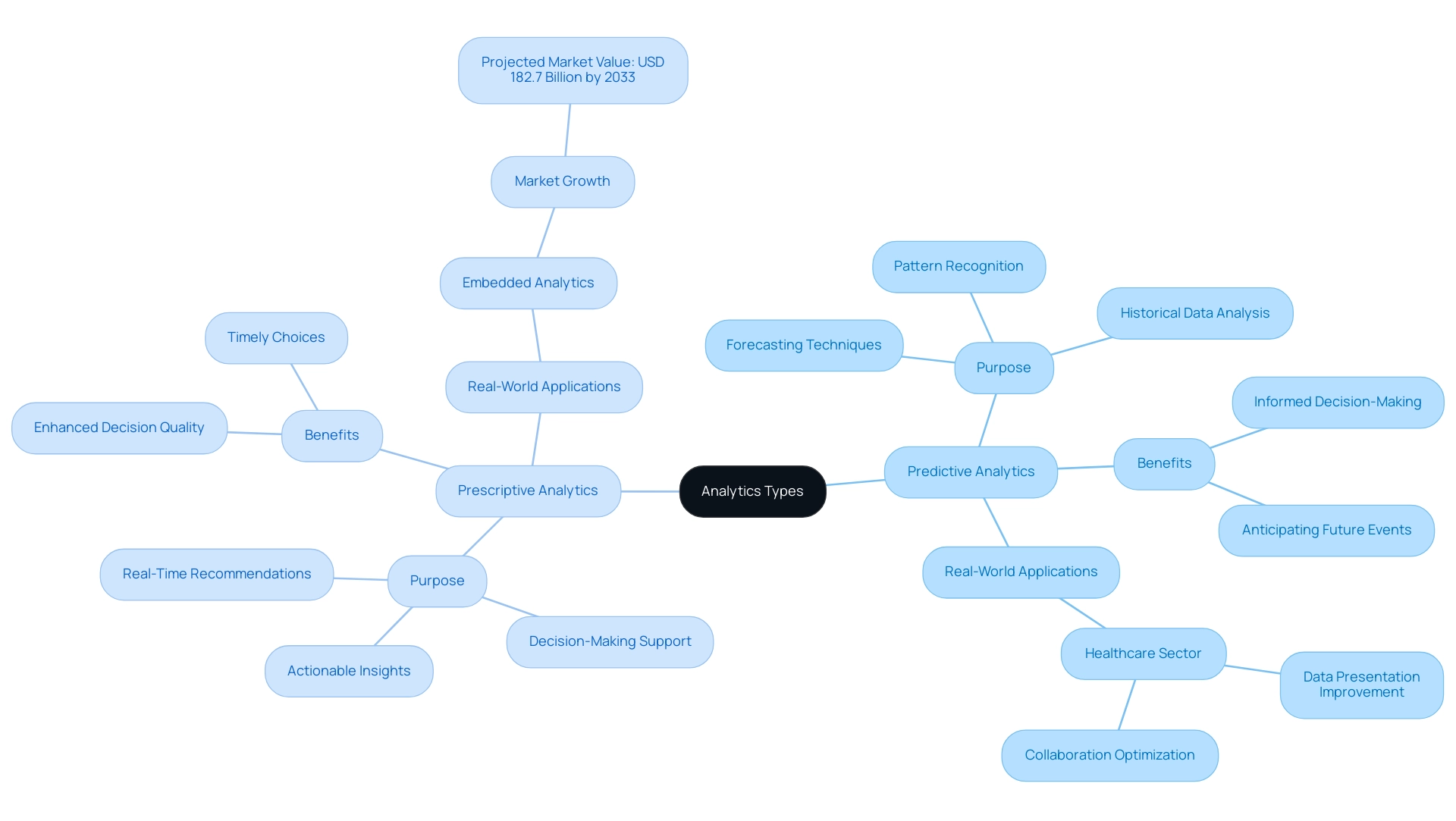
The Significance of Predictive Analytics in Forecasting
In sectors such as finance, healthcare, and retail, predictive analysis exemplifies an analytics type that forecasts future events, empowering organizations to anticipate market trends, customer behaviors, and operational challenges. For instance, in finance, forecasting models assess credit risk, enabling institutions to make informed lending decisions and mitigate potential losses. In healthcare, forecast modeling anticipates patient admission rates and recognizes patient utilization trends, allowing hospitals to enhance staffing and resource distribution, ultimately improving patient care and operational efficiency.
As Bilyana Petrova notes, “As medical professionals can more accurately diagnose patients, they can determine the most effective course of treatment tailored to the patient’s unique health situation.”
The significance of forecasting data extends beyond individual entities; it plays a crucial role in public health administration by anticipating disease outbreaks and enabling preventive actions. This proactive approach not only enhances health outcomes but also reduces costs associated with emergency responses.
In retail, firms like Netflix and Amazon showcase the power of forecasting methods through their recommendation systems. By analyzing customer behavior data, these organizations customize content and product offerings to individual preferences, significantly boosting customer engagement and satisfaction. This data-driven strategy has proven to enhance operational efficiency, as businesses can allocate resources more effectively based on anticipated demand.
As we approach 2025, the importance of forecasting data in finance, healthcare, and retail prompts a reevaluation of which analytics type forecasts future events. Organizations leveraging these insights can enhance operational efficiency and drive innovation and growth. For example, a mid-sized healthcare company that implemented GUI automation through Creatum GmbH experienced a 70% reduction in data entry errors and a 50% acceleration in software testing processes, leading to an 80% improvement in workflow efficiency.
As Herr Malte-Nils Hunold, VP Financial Services at NSB GROUP, states, “The implementation of GUI automation has transformed our operational processes, allowing us to focus more on patient care rather than administrative tasks.” Such measurable outcomes underscore the transformative impact of automation on operational efficiency. Expert opinions emphasize that the ability to anticipate market trends and customer needs is essential for maintaining a competitive edge in today’s data-rich environment.
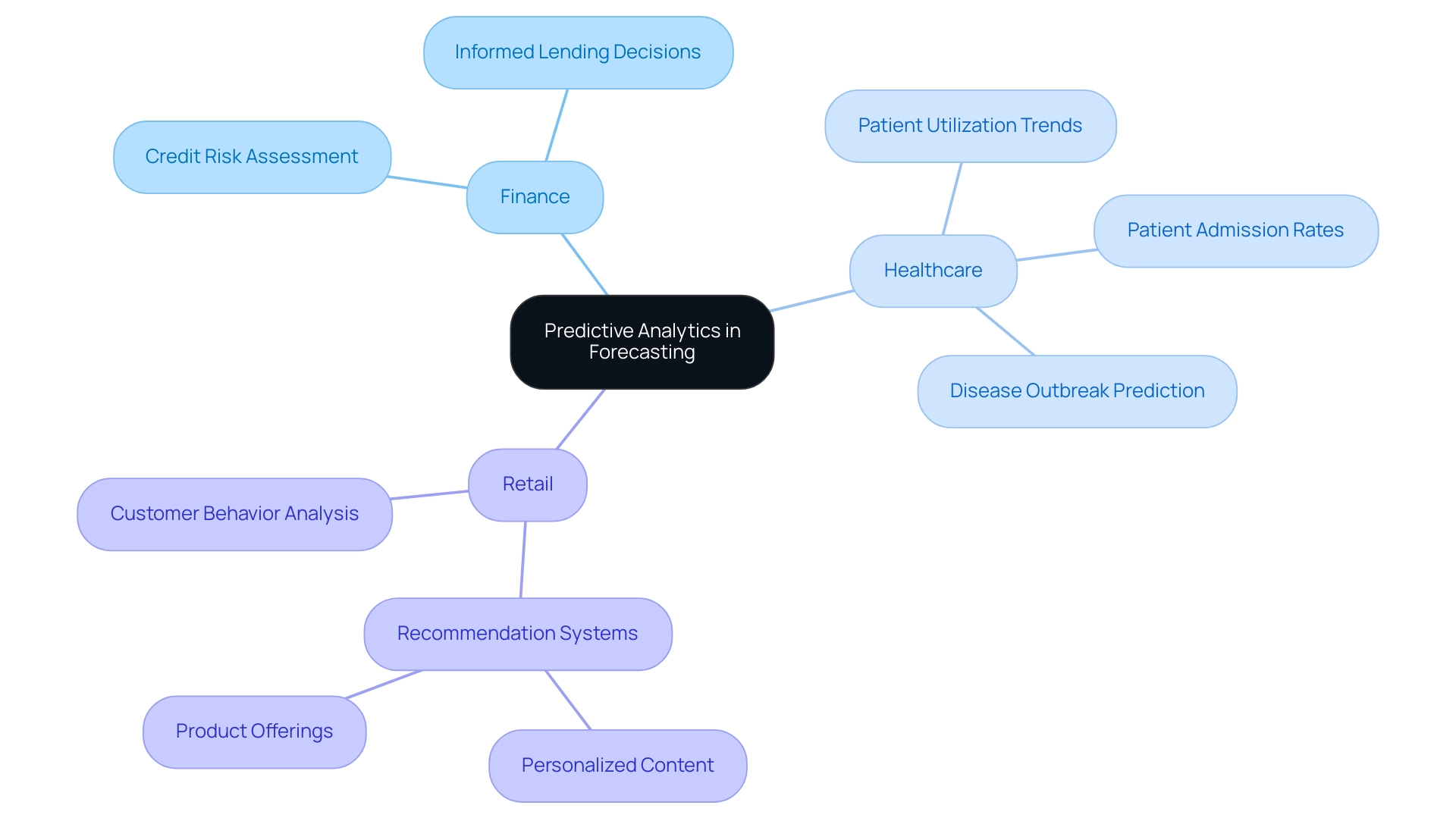
Techniques and Models in Predictive Analytics
In the realm of predictive analysis, several key techniques stand out for their effectiveness, particularly when considering which analytics type forecasts future events. Among these, regression analysis, decision trees, and machine learning algorithms play pivotal roles. As companies increasingly seek to enhance operational efficiency, integrating Robotic Process Automation (RPA) into these analytics processes can significantly streamline workflows, reduce manual effort, and minimize errors, ultimately freeing teams for more strategic, value-adding work.
Regression analysis is a statistical technique that identifies relationships between variables, enabling organizations to understand how changes in one variable can impact another. This method is particularly efficient in forecasting models, which aim to predict future occurrences, as it provides a solid foundation for making informed decisions based on historical data. For instance, businesses can utilize regression analysis to anticipate sales trends influenced by factors such as seasonality, marketing efforts, and economic indicators.
By automating data gathering and analysis through RPA, organizations can ensure their forecasting models are based on the most current and accurate information, thus enhancing the reliability of predictions and minimizing human error.
Decision trees, conversely, offer a visual representation of decision-making processes. They decompose complex decisions into simpler, more manageable components, facilitating stakeholder understanding of potential outcomes from various choices. This technique not only aids in predicting results but also bolsters strategic planning by illustrating the pathways leading to different outcomes.
RPA can enhance the decision-making process by automating data inputs for these models, allowing for quicker, more informed decisions while reducing the risk of inaccuracies.
Machine learning algorithms, such as neural networks and support vector machines, are increasingly employed in forecasting due to their ability to analyze large datasets and uncover complex patterns. These algorithms excel in handling large-scale forecasting tasks, making them invaluable in sectors such as healthcare and finance. For example, machine learning-driven forecasting techniques can refine treatment strategies in healthcare by analyzing patient data to predict health outcomes, thereby improving service delivery.
Indeed, forecasting analysis can significantly enhance treatment and healthcare services, showcasing its practical advantages in real-world applications. Incorporating RPA into these processes can further improve efficiency by automating routine tasks, allowing professionals to focus on more strategic initiatives and driving business growth.
As of 2025, the landscape of predictive analytics continues to evolve, with the latest techniques emphasizing the integration of advanced algorithms that enhance accuracy and efficiency. Techniques such as ensemble methods, which combine multiple models to improve predictions, are gaining traction. Additionally, outlier detection models are becoming essential for identifying anomalous points that may indicate fraud or operational inefficiencies, particularly in sectors like retail and finance.
As noted by Valeryia Yeusianeva, “The outlier model identifies anomalous elements in a set that may exist either independently or alongside other categories and numbers.” These models not only assist in anomaly detection but also play a crucial role in cost savings for businesses by identifying potential fraud. RPA can contribute in this area by automating transaction monitoring and flagging anomalies for further investigation, thereby enhancing operational efficiency.
Real-world applications of these techniques underscore their value. Organizations leveraging predictive data analysis can uncover insights that lead to enhanced operational efficiency, increased profitability, and improved customer satisfaction. By employing regression analysis, decision trees, and machine learning algorithms, alongside RPA, businesses can anticipate trends and refine their strategies based on insights into consumer behavior and market dynamics.
The case study titled “Business Value of Predictive Analytics Techniques” illustrates how these methodologies equip businesses with tools to prepare for future trends and optimize decision-making, further emphasizing their significance in today’s data-driven landscape.
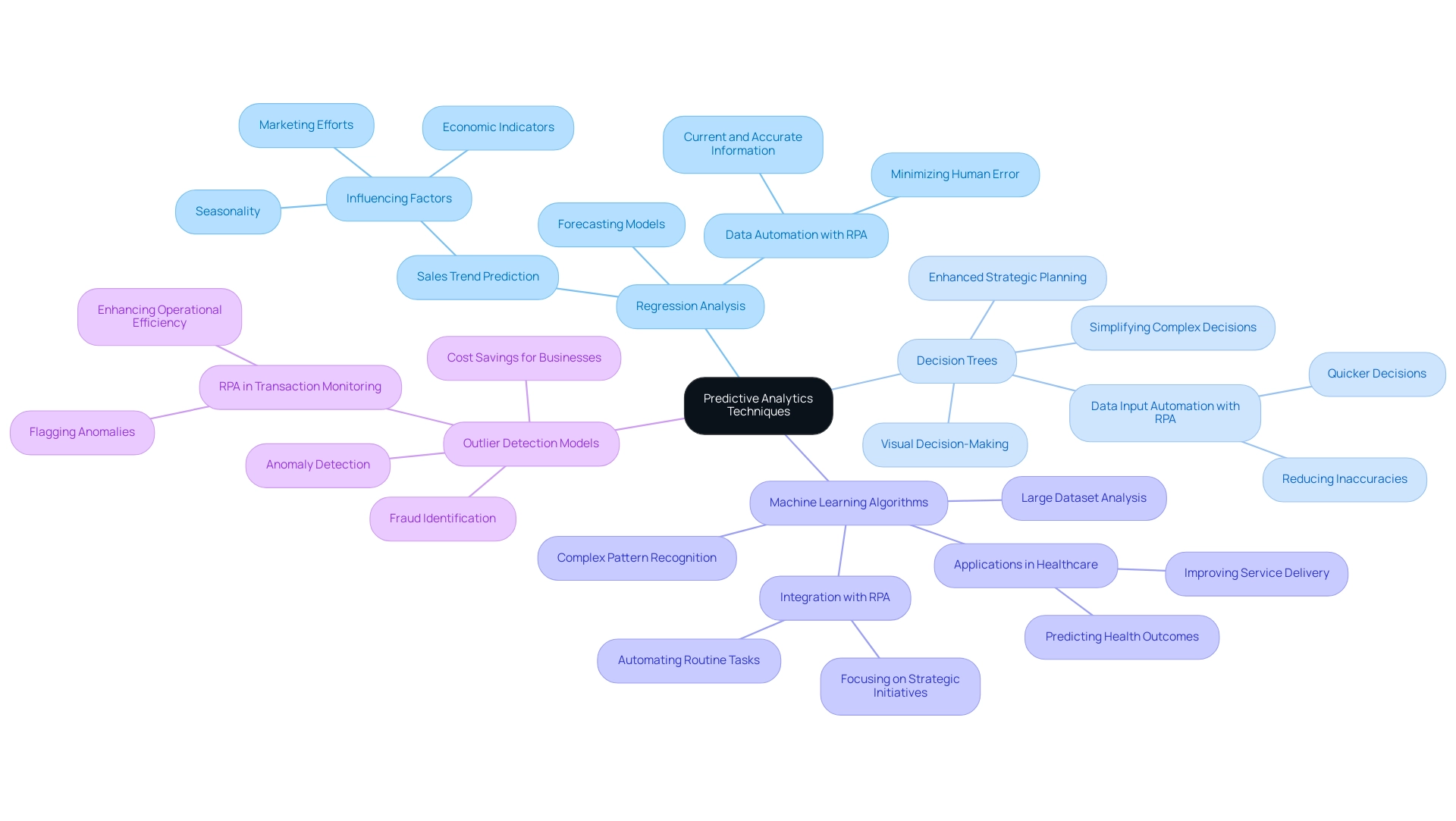
Predictive vs. Prescriptive Analytics: Key Differences
Predictive analysis represents a powerful tool in analytics, focusing on forecasting future events by examining historical data and potential outcomes. This approach empowers businesses to anticipate trends and behaviors effectively. However, measuring metrics in isolation can limit its effectiveness, as it may not provide a comprehensive view of potential outcomes. For instance, a coal mining company utilized predictive analysis to uncover patterns in operational efficiency, resulting in a 4% increase in annual revenue—an impressive $250 million boost—while achieving 100% customer satisfaction.
This analytical approach informs organizations about potential occurrences, allowing them to prepare accordingly for what lies ahead. In contrast, prescriptive analysis elevates this process by not only predicting outcomes but also recommending specific actions to achieve desired results. By synthesizing multiple data sources and leveraging machine learning techniques, prescriptive analysis offers actionable insights. A notable example of this can be seen in the healthcare sector, where prescriptive data analysis plays a crucial role in decision-making processes.
By addressing inquiries related to service suggestions and departmental support requirements, prescriptive analysis empowers healthcare entities to make informed choices, enhance operations, and improve patient care. The primary distinction between these two analytical types lies in their focus: predictive analysis identifies trends and patterns, while prescriptive analysis evaluates the overall impacts of various decisions and recommends optimal courses of action. This distinction is vital for organizations striving to refine their decision-making frameworks.
As businesses increasingly adopt data-driven strategies, understanding how predictive analytics informs potential outcomes and how prescriptive analytics enhances decision-making will be essential for achieving operational excellence. Moreover, integrating Robotic Process Automation (RPA) from Creatum GmbH can significantly boost operational efficiency by streamlining repetitive tasks, allowing teams to concentrate on strategic initiatives.
Tailored AI solutions, including Small Language Models and GenAI Workshops, further enhance information quality and governance, addressing challenges in business reporting such as poor master information quality and inconsistencies. Additionally, leveraging Business Intelligence tools like Power BI transforms raw data into actionable insights, ensuring efficient reporting and informed decision-making. By employing these advanced data analysis tools and technologies, organizations can drive growth and innovation in an increasingly competitive landscape.
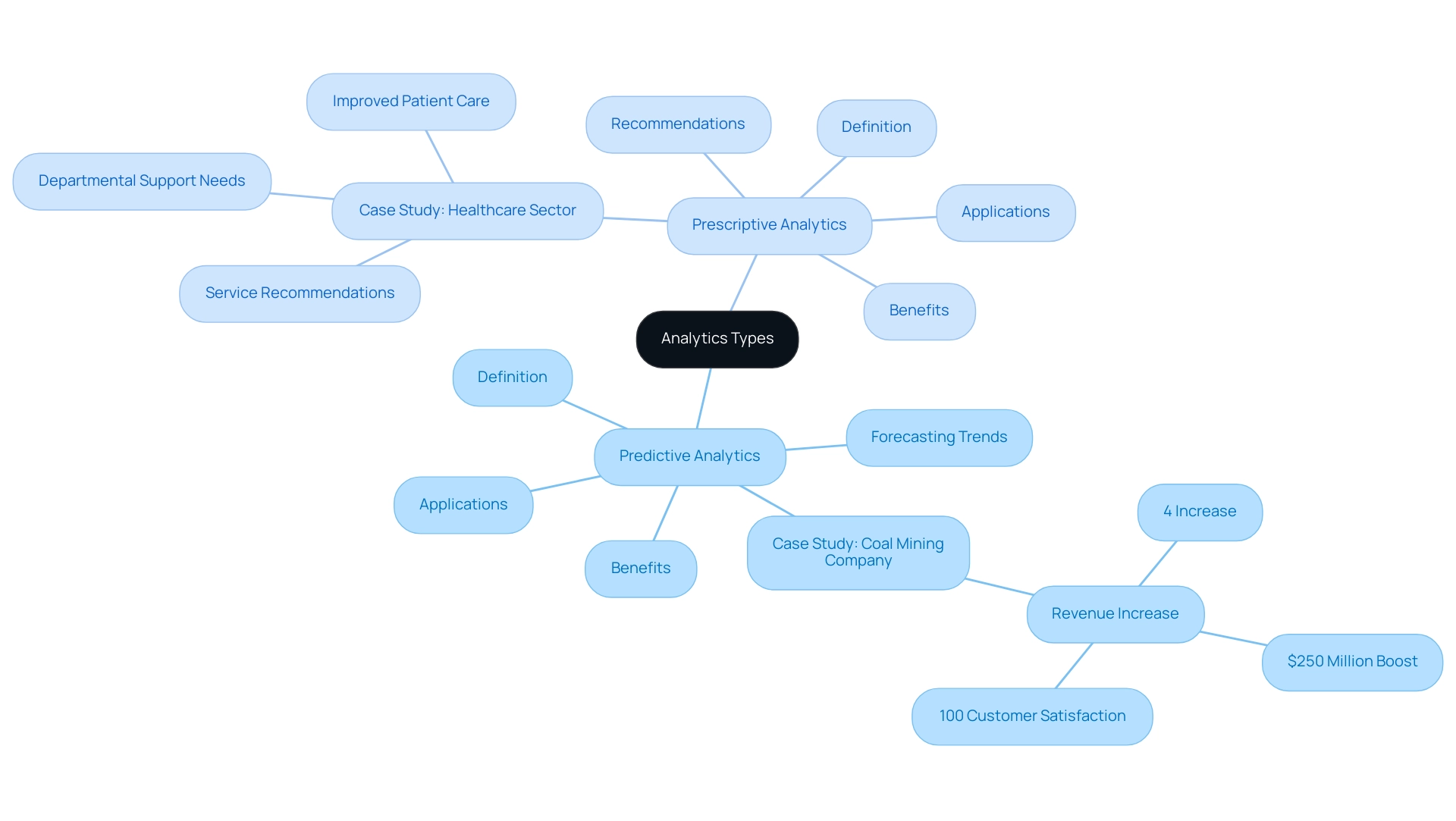
Leveraging Prescriptive Analytics for Strategic Decision-Making
Prescriptive analysis is emerging as a pivotal tool in supply chain management, marketing, and finance, significantly enhancing decision-making processes. In supply chain management, for instance, prescriptive analysis can determine optimal inventory levels by analyzing predicted demand patterns. This ensures businesses maintain sufficient stock without overcommitting resources, leading to warehouse optimization that can increase capacity by over 15% and improve productivity by more than 10%.
Moreover, integrating Robotic Process Automation (RPA) into these workflows streamlines operations, reduces errors, and frees up teams for more strategic tasks, ultimately driving operational efficiency.
In marketing, prescriptive analytics plays a crucial role by suggesting targeted campaigns based on comprehensive customer behavior analysis. By leveraging data-driven insights, organizations can tailor their marketing strategies to resonate with specific audience segments, maximizing engagement and conversion rates. The integration of RPA and business intelligence tools enhances this process, enabling faster adjustments based on real-time information.
A notable case study involves a global apparel giant that faced challenges such as constant disruptions and inconsistent demand profiles. By employing prescriptive analysis for pricing and promotion enhancement, along with RPA for automating information gathering and reporting, the company gained insights into actual product demand and received practical suggestions for optimal pricing strategies. This approach not only helped maintain balanced inventory but also ensured timely replenishment of high-demand products, effectively bridging the gap between capacity, demand, and supply.
The impact of prescriptive data analysis extends beyond operational efficiency; it empowers organizations to make informed decisions that preemptively address potential risks. As emphasized by Amy Augustine, senior director of network supply chain at USCellular, “The right technology and information collection practices assist us in recognizing when we face a potential risk, enabling us to make choices before it evolves into an issue, and to adjust the supply chain to permit minimal or no disruption.” This highlights the significance of technology, including RPA, and information quality in effectively employing prescriptive analysis.
Furthermore, organizations are encouraged to clean and verify their data to maximize the effectiveness of these analyses. Overall, prescriptive analysis, enhanced by RPA, serves as a critical component in navigating the complexities of modern business environments, driving strategic decision-making across various sectors. Client testimonials from leaders like Herr Malte-Nils Hunold of NSB GROUP and Herr Sebastian Rusdorf of Hellmann Marine Solutions further affirm the transformative impact of Creatum GmbH’s technology solutions in enhancing operational efficiency and driving business growth.
Additionally, tailored AI solutions from Creatum GmbH can help businesses identify the right technologies to address their specific needs, navigating the rapidly evolving AI landscape and overcoming the challenges posed by manual, repetitive tasks.
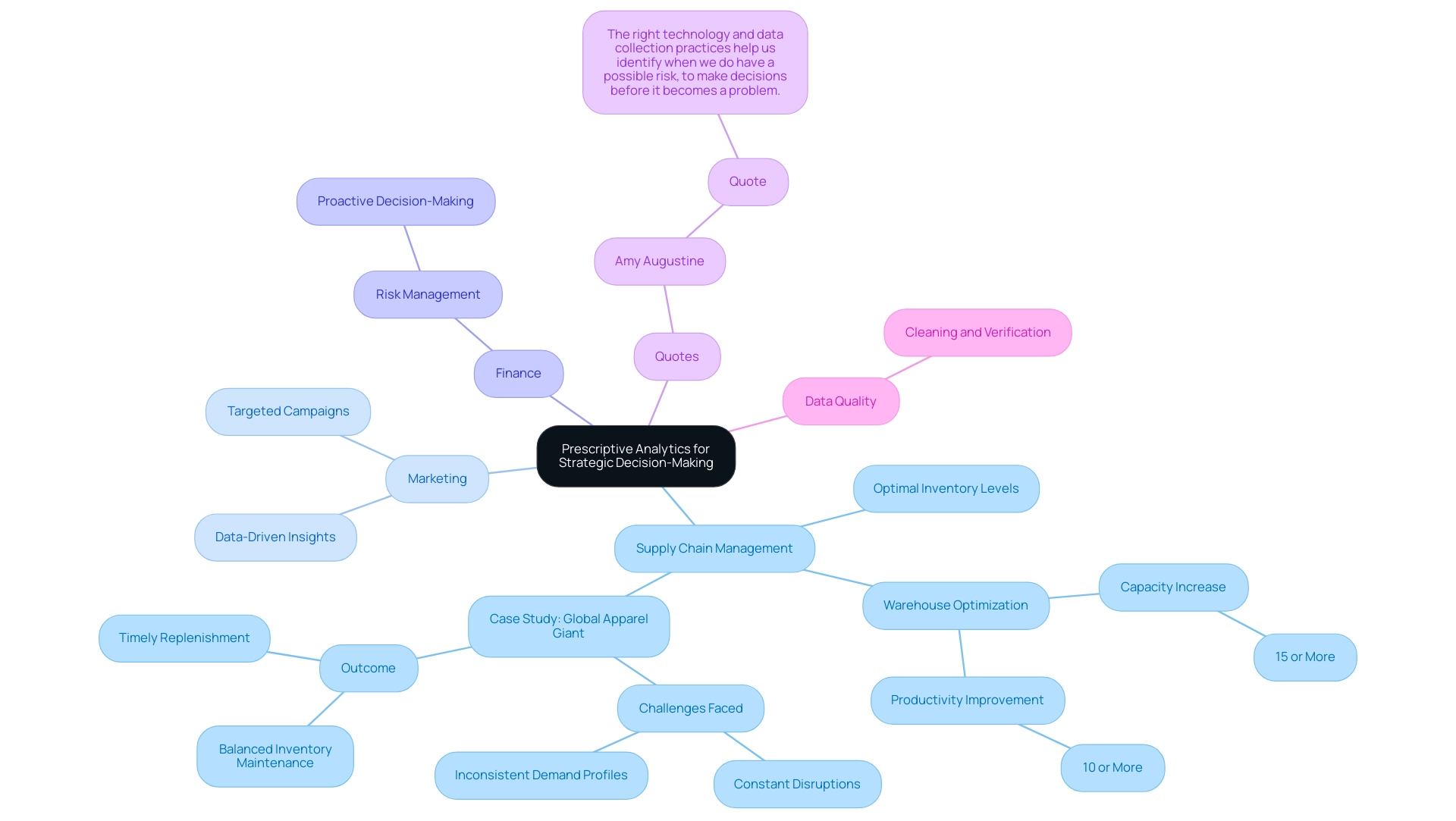
Case Studies: Real-World Applications of Predictive and Prescriptive Analytics
In the retail industry, a leading chain harnessed the power of foresight analysis to accurately predict sales patterns. This capability enabled them to optimize inventory management and significantly reduce stock shortages. Such a strategic approach not only improved operational efficiency but also elevated customer satisfaction by ensuring product availability. Recent studies underscore that forecasting analysis, a vital type of analytics aimed at predicting future events, has become essential for retail success. Organizations that develop robust forecasting capabilities experience substantial performance benefits.
Furthermore, forecasting analysis aids retailers in establishing equitable pricing strategies based on inventory levels and competitor pricing.
In parallel, a healthcare provider adopted prescriptive analysis to enhance patient outcomes. By leveraging predictive models to assess patient responses, they could recommend personalized treatment plans tailored to individual needs. This aligns with insights from David Ajiga, who highlights the growing intersection of Artificial Intelligence (AI) and financial forecasting, particularly in the stock market. His perspective underscores the critical role of analytics in driving success across various industries.
The significance of real-time decision-making and personalized marketing campaigns, enabled by Big Data Analytics, is paramount. These elements greatly enhance customer satisfaction and loyalty. The case study titled “Emerging Data Sources in Retail” illustrates how new data sources, such as location-based data and social media interactions, yield deeper insights into consumer preferences. This, in turn, refines marketing strategies and boosts customer engagement through more personalized and relevant offerings.
Client testimonials further validate the transformative potential of Creatum GmbH’s technology solutions. For example, Herr Malte-Nils Hunold, VP of Financial Services at NSB GROUP, remarked on how the implementation of Robotic Process Automation (RPA) streamlined their manual workflows, significantly enhancing operational efficiency. Similarly, Herr Sebastian Rusdorf, Regional Sales Director Europe at Hellmann Marine Solutions & Cruise Logistics, emphasized the impact of tailored AI solutions in navigating the complex AI landscape, enabling their company to align technology with specific business objectives.
Additionally, Sascha Rudloff, Team Leader of IT and Process Management at PALFINGER Tail Lifts GMBH, noted that Creatum’s solutions not only minimized errors but also liberated their team for more strategic, value-adding tasks.
These compelling case studies and testimonials underscore the essential roles of forecasting and prescriptive analysis, along with RPA, in fostering success across diverse sectors. As organizations increasingly adopt these analytical approaches, they gain a competitive edge by making informed decisions that enhance performance and drive innovation.
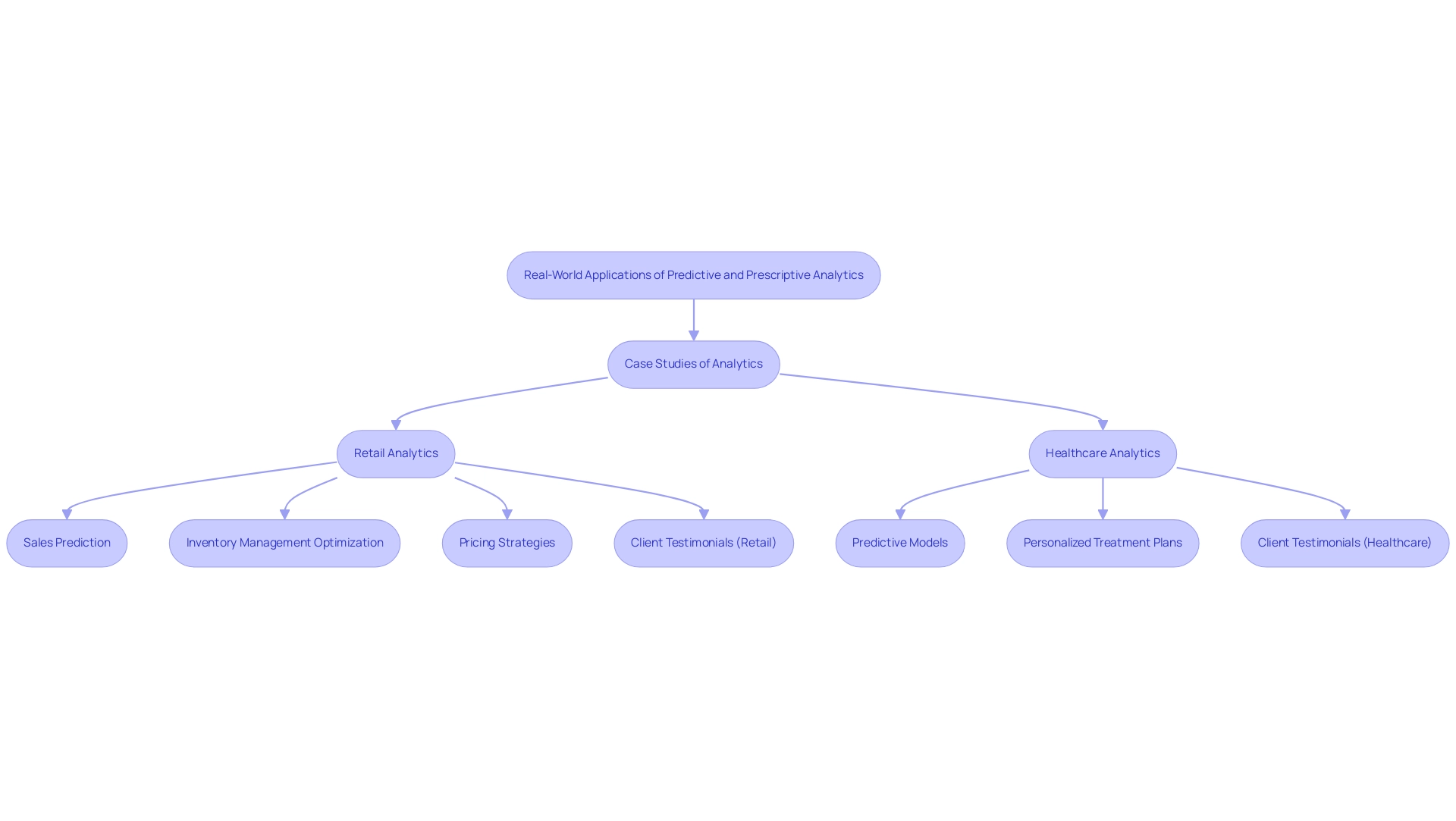
Challenges in Implementing Predictive and Prescriptive Analytics
Organizations frequently grapple with significant challenges when implementing predictive and prescriptive analytics, including quality issues, integration complexities, and the necessity for specialized skills. The integrity of information is paramount; clean and relevant information is essential for generating accurate predictions. For instance, a case study titled ‘Challenges and Opportunities in Big Data for Healthcare‘ highlights how the increasing volume of data collected through advanced information technology presents both challenges and opportunities in leveraging big data for healthcare advancements.
Effective predictive modeling is essential to navigate these complexities, as it can significantly enhance healthcare delivery and patient outcomes. Moreover, integrating data analysis tools with existing systems often presents technical hurdles that can impede progress. Organizations must also consider the investment in training staff to effectively utilize these advanced data tools.
This is where Creatum GmbH’s 3-Day Power BI Sprint comes into play, offering a quick start to building professional reports that enable companies to concentrate on actionable insights. The 3-Day Power BI Sprint has been shown to reduce report creation time by up to 50%, enabling teams to make data-driven decisions faster. Optimal approaches for addressing these obstacles, based on recent findings, involve:
- Utilizing user-friendly tools
- Integrating data analysis within current workflows
- Automating regular tasks through Robotic Process Automation (RPA)
- Concentrating on actionable insights
By addressing these concerns, organizations can fully leverage forecasting and prescriptive analysis, which includes the analytics type that attempts to forecast what will happen in the future, ultimately enhancing decision-making and operational efficiency. Furthermore, the significance of strong forecasting models is underscored by the need for effective strategies to navigate the complexities of data quality, as highlighted in the literature (PMID 32175361).
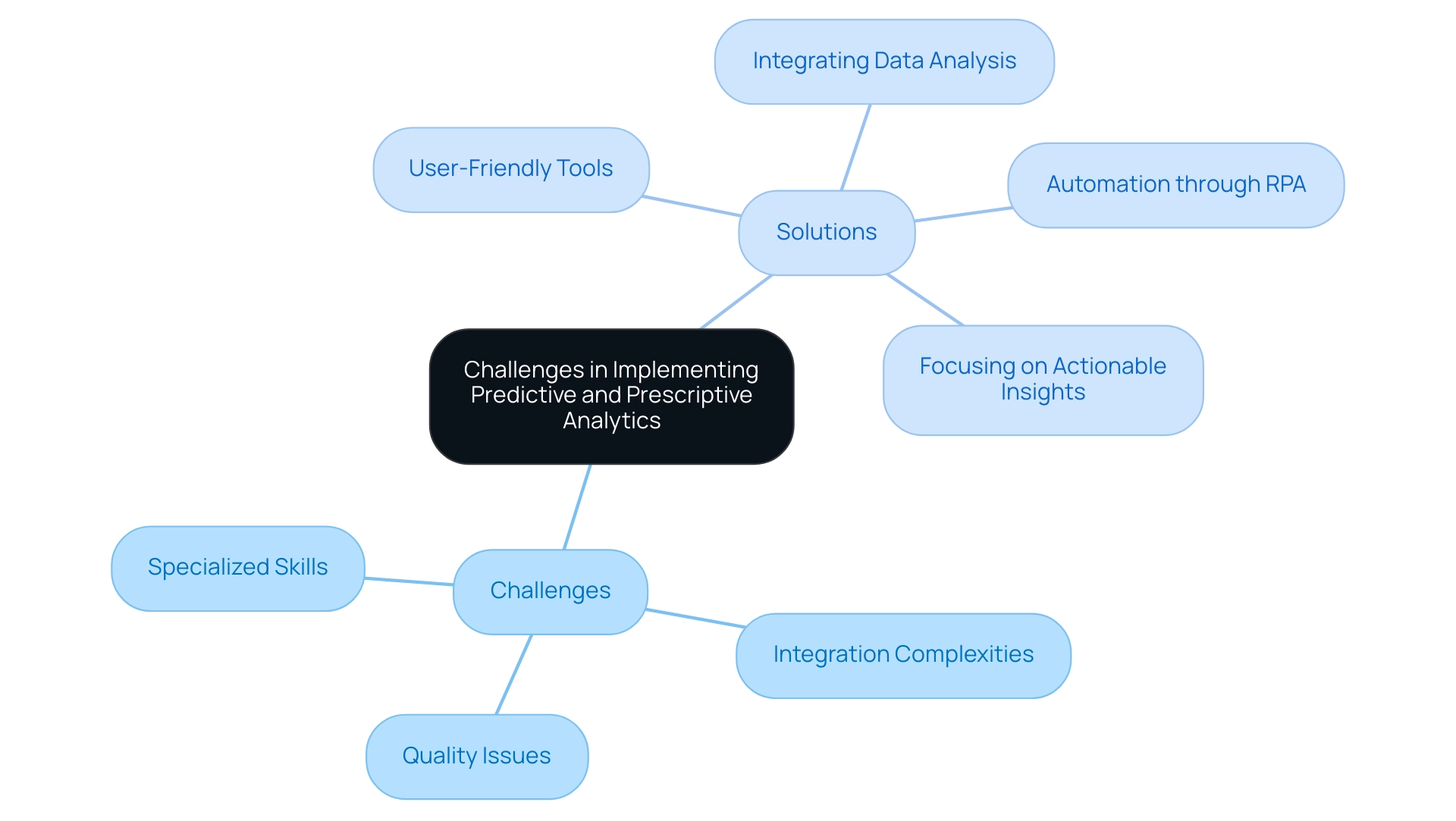
The Future of Predictive and Prescriptive Analytics
The future landscape of predictive and prescriptive data analysis is poised for remarkable expansion, largely fueled by breakthroughs in artificial intelligence (AI) and machine learning. As organizations increasingly shift towards data-driven decision-making, the integration of real-time analysis and automated insights is anticipated to become standard practice. This shift is underscored by the growing reliance on large information sets, with companies harnessing this data to enhance customer experiences and operational effectiveness.
In reality, businesses are progressively depending on extensive information sets to make insight-rich choices that boost performance.
The rise of edge computing and the Internet of Things (IoT) is further enhancing the capabilities of forecasting and prescriptive analysis. These technologies facilitate the gathering and examination of information at unprecedented speeds, empowering businesses to obtain actionable insights in real-time. For instance, companies like Unifi Inc. have implemented advanced safety risk analysis models to enhance ground handling operations, showcasing a real-world application of predictive methods in improving operational efficiency.
Looking ahead to 2025, the market for predictive and prescriptive techniques is projected to witness substantial growth, particularly in sectors such as finance, healthcare, and retail. North America leads this trend, driven by significant investments in analytical technologies and a robust information ecosystem. The emphasis on research and development in these areas is expected to propel market growth, as companies seek innovative methods to enhance operational efficiency through tools like Robotic Process Automation (RPA) and tailored AI solutions.
This is supported by a case study demonstrating that North America dominates the predictive and prescriptive analysis market due to significant investments and a strong information ecosystem. Furthermore, expert insights suggest that the integration of AI and machine learning with predictive analysis—analytics that forecasts future events—will not only improve forecasting accuracy but also enable organizations to predict future trends with greater precision. As businesses continue to adopt these advanced data solutions, the potential for enhanced decision-making and strategic planning will be transformative, positioning them for sustained success in an increasingly competitive landscape.
Additionally, companies like Creatum GmbH and IBM are key players in this space, providing comprehensive analytics solutions that underscore the importance of data management and advanced analytics, alongside the critical role of RPA in automating manual workflows and enhancing operational efficiency.
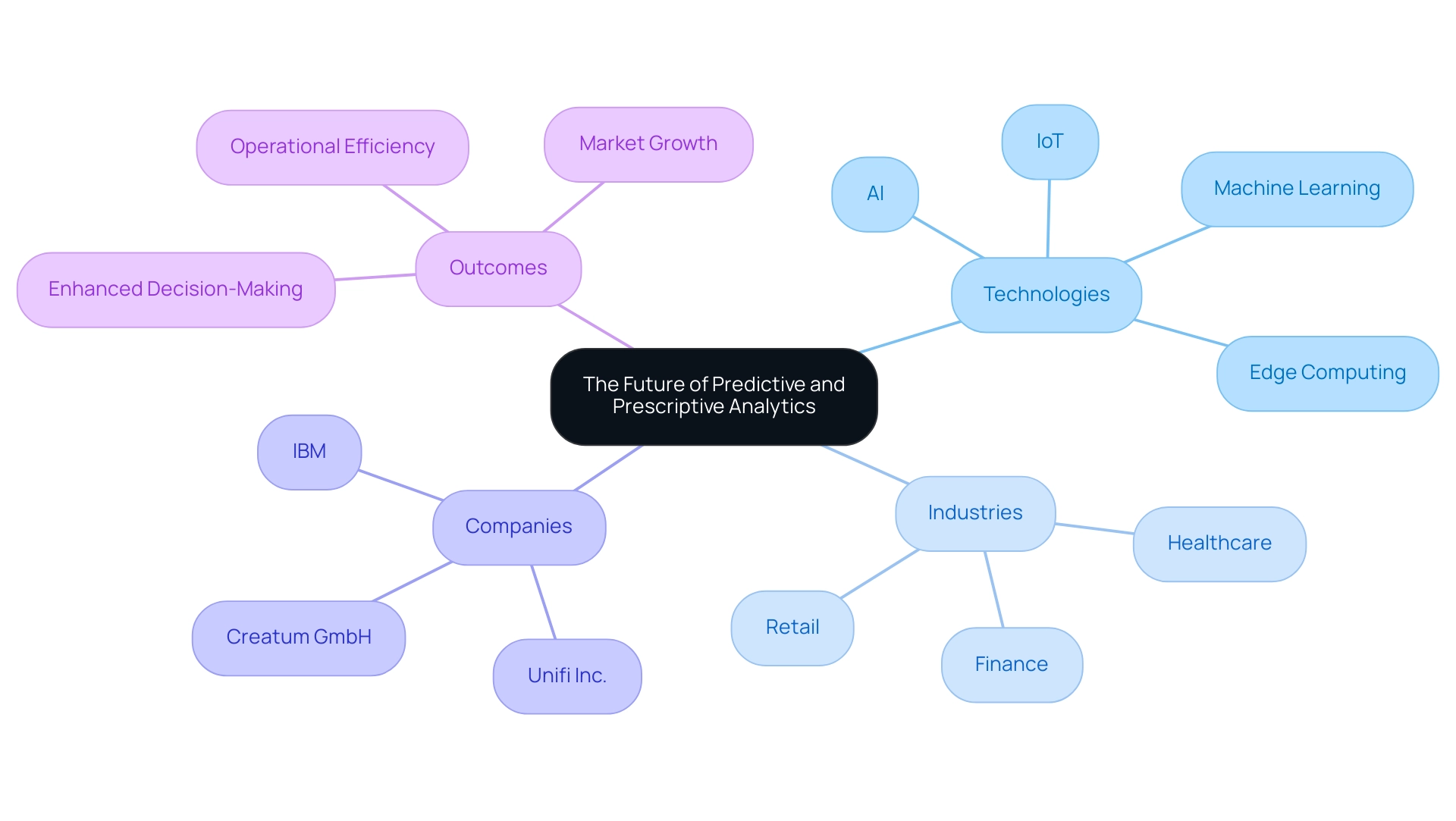
Conclusion
The exploration of predictive and prescriptive analytics underscores their crucial roles in navigating the complexities of modern business environments. Predictive analytics, primarily focused on forecasting future trends and behaviors through historical data analysis, empowers organizations to anticipate various scenarios and make informed decisions. In sectors such as finance, healthcare, and retail, the ability to predict outcomes is essential for enhancing operational efficiency and driving innovation.
Conversely, prescriptive analytics elevates the decision-making process by not only predicting outcomes but also recommending specific actions to achieve desired results. This analytical approach synthesizes multiple data sources to provide actionable insights, particularly in dynamic environments where timely decisions are critical. The integration of advanced technologies, including Robotic Process Automation and tailored AI solutions, further enhances the effectiveness of both analytics types, streamlining workflows and improving data quality.
As organizations increasingly embrace data-driven strategies, understanding the distinct yet complementary roles of predictive and prescriptive analytics is imperative. Leveraging these tools fosters operational excellence and positions companies for sustained growth and innovation in an increasingly competitive landscape. The future of analytics is promising, with advancements in AI and machine learning poised to refine forecasting accuracy and empower businesses to make strategic decisions that drive success. Embracing these analytical capabilities will undoubtedly unlock new opportunities and enhance overall performance across various industries.
Frequently Asked Questions
What is predictive analysis?
Predictive analysis is a type of analytics that forecasts future events by using historical data and statistical algorithms to project outcomes, helping organizations address the question, ‘What might occur?’
How does predictive analysis benefit organizations?
By identifying patterns and trends from past information, organizations can anticipate potential scenarios and make informed decisions, thereby enhancing their decision-making processes.
What percentage of firms currently use forecasting techniques?
85% of firms currently employ forecasting techniques to improve their decision-making processes.
What is the difference between predictive analysis and prescriptive analysis?
Predictive analysis forecasts results based on historical data, while prescriptive analysis not only anticipates outcomes but also recommends specific actions to take based on those forecasts.
Why is prescriptive analysis particularly useful?
Prescriptive analysis is especially advantageous in dynamic contexts where timely and informed decisions are critical for success.
What are current trends regarding predictive and prescriptive analysis for 2025?
There is an increasing emphasis on integrating these analytical types into business operations, with a focus on testing and validation, explicit decision rights, and continuous learning.
How can AI solutions enhance predictive and prescriptive analysis?
AI solutions, such as customized Small Language Models and GenAI workshops, can improve information quality and address governance challenges in business reporting, enhancing the accuracy of insights.
What real-world examples illustrate the impact of predictive analysis?
In healthcare, predictive analysis is used to forecast patient admission rates, improving staffing and resource distribution. In retail, companies like Netflix and Amazon utilize forecasting to personalize recommendations, boosting customer engagement.
How does predictive analysis contribute to public health?
Predictive analysis plays a crucial role in anticipating disease outbreaks, enabling preventive actions that improve health outcomes and reduce emergency response costs.
What is the projected market value for embedded data analysis by 2033?
The market for embedded data analysis is projected to reach USD 182.7 billion by 2033, indicating a growing demand for integrated data solutions.
How does Robotic Process Automation (RPA) relate to predictive analysis?
RPA enhances productivity by streamlining workflows and reducing operational costs, which can be informed by insights derived from predictive analysis.
What role do self-service data platforms play in analytics?
Self-service data platforms empower non-technical users to explore data and generate insights independently, without relying on data scientists or IT teams.
How do forecasting and prescriptive analysis drive growth and innovation?
Both types of analysis facilitate informed decision-making in a data-driven environment, which is essential for driving growth and innovation within organizations.

